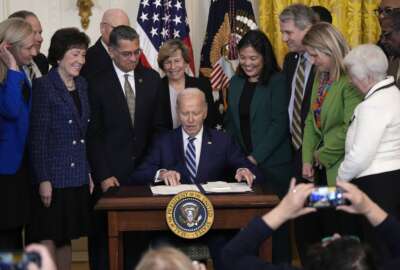IG encourages USPS to follow private sector lead for benefit programs
The Postal Service Inspector General recommended that USPS make changes to its decades-old benefit programs that cost the agency millions.
By Stephanie Wasko
Special to Federal News Radio
In order to climb out of its traditional financial struggles, the Postal Service should consider renovating its decades-old benefits programs by moving to a modern, private-sector model.
It also should consider implementing contributory retirement plans similar to a 401(k), switching from categorized leave to a paid-time-off plan and reducing carry-over leave days.
These are a few of the recommendations in a new report from the USPS inspector general, which benchmarked the service’s leave and retirement benefits programs against the private sector. Auditors reviewed six private and two government sector organizations.
The IG stated that the Postal Service incurred more than $47 billion in compensation and benefits expenses in fiscal year 2013. Of that, $6 billion came from retirement benefits.
“The Postal Service’s retirement expense was about 12 percent of total annual compensation and benefits expenses in FYs 2011 through 2013,” the report said. “In the private sector, retirement and savings benefits average 3.7 percent of total compensation and benefits costs.”
All Postal Service employees fall under either the Civil Service Retirement System or the Federal Employees Retirement System. Under FERS, employees already have moved closer to the private sector. Employees control their investments through the Thrift Savings Plan and only a small portion of the retirement package is a defined benefit.
In the report, seven of the eight benchmarked organizations had transitioned from defined benefit pension plans to a 401(k) or 403(b) defined contribution plan. These organizations reported savings from $1 billion to $5 billion.
Benefits of moving away from a traditional retirement plan
The USPS IG said that by switching away from the traditional retirement plan to a contribution plan, employees take responsibility for their own retirement funds and companies avoid mounting pension debt.
“As workers become more mobile and transient throughout their careers, many organizations are adjusting their retirement benefits programs to cater to an evolving workforce and putting the employee in control of his or her financial future,” auditors wrote.
Additionally, USPS could find more cost savings if it modernized its leave plan.
It still uses a traditional plan with categories for annual, personal, sick, military and holiday leave, which outdates the more simplified systems of many private-sector companies.
“Since 2000, four of the six private sector companies transitioned to a combined leave benefits program, consolidating leave into fewer categories. In addition, when they transitioned, two of those four reduced the overall number of leave days provided to employees,” the report stated.
The IG found paid-time-off plans have become a popular move to reduce costs and the time employees are away from work. The PTO plans, similar to the contribution retirement plans, put more power in the hands of the employee and relieve some administrative duties.
“Employees no longer have to worry about classifying their time off, and the plans are simplified and easier for employers to track and manage,” auditors wrote.
Cutting back on allowable carryover leave
In addition to minimizing leave buckets and days off, the IG suggested USPS decrease the amount of carryover leave permitted.
“Postal Service employees can carry over 55 or more days of annual leave each leave year, and employees are not limited by the amount of sick leave they can carry over,” auditors wrote. “However, the benchmarked companies provided much more restrictive leave carryover. Limiting the leave employees can carry over decreases the money the company must pay out upon employee separation and reduces the money it must set aside to cover employee payments for these leave balances.”
The IG said the Postal Service should look at the modernized benefit systems of the benchmarked organizations but also said the challenges specific to USPS when considering changing leave benefit programs include legal requirements concerning benefits, bargaining with employee unions, outdated technology and impact on employees.
Stephanie Wasko is an intern with Federal News Radio.
RELATED STORIES:
USPS says overhauling health benefits key to postal reform
USPS warns of default on retiree benefits
Latest postal reform bill includes USPS-only health plan
What can USPS learn from TRICARE in funding retiree health care costs?
Copyright © 2025 Federal News Network. All rights reserved. This website is not intended for users located within the European Economic Area.





